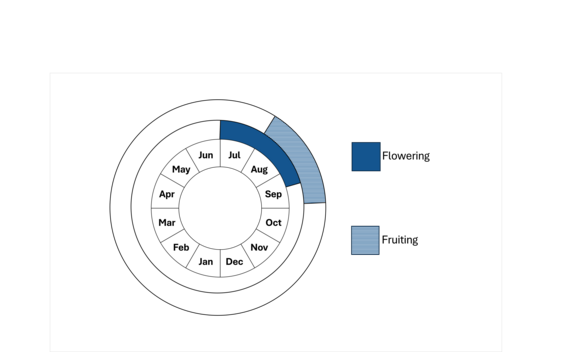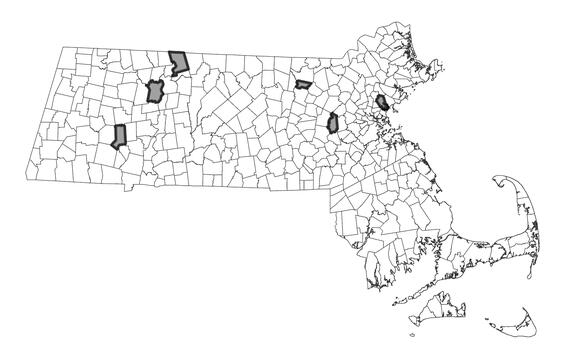- Scientific name: Senna hebecarpa
- Species of Greatest Conservation Need (MA State Wildlife Action Plan)
- Endangered (MA Endangered Species Act)
Description
Wild senna is a robust, herbaceous perennial in the pea family (Fabaceae), growing 0.9-2 m (3-6.5 ft) tall. The compound leaves have 6 to 10 pairs of simple (i.e., without lobes or teeth) leaflets. Racemes of showy, five-petaled, yellow flowers about 2 cm (0.8 in) across are present from late July through August and occasionally into mid-September. The fruits are flattened, pea-like pods, 7-12 cm (3-5 in) long, each containing up to 12 flat, roundish seeds with a depressed center. Fruits are produced from mid-August through late September and may persist into October. Plants spread vegetatively by rhizomes and may form dense clonal patches.
Wild senna has compound leaves and pods similar to those of other species in the Pea family. It is distinguished by:
- Club-shaped or obovoid petiole glands
- Joints of pods are about as long as wide
- Yellow flowers have five distinct petals that are not fused
Wild senna is the only native Senna species known from Massachusetts. Partridge pea (Chamaecrista fasciculata) might be mistaken for wild senna but it is smaller, rarely reaching 80 cm (30 in) in height, and has larger flowers (> 2.5 cm; > 1 in).
Life cycle and behavior
This is a perennial species.

Population status
Wild senna is listed under the Massachusetts Endangered Species Act as Endangered. All listed species are protected from killing, collecting, possessing, or sale, and from activities that would destroy habitat and thus directly or indirectly cause mortality or disrupt critical behaviors. MassWildlife’s Natural Heritage & Endangered Species Program database has 13 records from 5 counties: Essex, Franklin, Hampshire, Middlesex, and Norfolk. Four of those records are within the last 25-year period. Wild senna was never common in Massachusetts and population declines during the 20th century have left it in a precarious position. A total of 25 populations were documented in Massachusetts during the 19th and 20th centuries; as of 2000, only two extant populations were known. Succession following agricultural abandonment and development are probably the primary causes for this decline.

Distribution in Massachusetts
1999-2024
Based on records in the Natural Heritage Database
Distribution and abundance
Wild senna is found from Maine to Ontario south to Georgia.
Habitat
Wild senna often occurs in areas with a history of disturbance, such as roadsides, fields, agricultural lands, utility rights-of-way, and the scour zone along stream edges. It may occur in both wetland and moist upland contexts; areas with rich alluvial soil are especially favorable. It is not typically found in areas with a forest canopy, but it does well in thickets in association with coarse herbs and shrubs.
Healthy habitats are vital for supporting native wildlife and plants. Explore habitats and learn about conservation and restoration in Massachusetts.
Threats
Extant populations of wild senna are on land owned or managed by the Massachusetts Division of Fisheries and Wildlife, affording good potential for protection and management. One population on a power line right-of-way is potentially threatened by infrastructure maintenance.
Conservation
Vegetation management is needed to maintain early successional habitats in and around remaining populations. All active management of rare plant populations (including invasive species removal) is subject to review under the Massachusetts Endangered Species Act and should be planned in close consultation with the MassWildlife’s Natural Heritage & Endangered Species Program.
References
Clark, F. H. 2001. Senna hebecarpa (Northern Wild Senna) Conservation and Research Plan for New England. New England Plant Conservation Program, Framingham, MA.
Gleason, H. A., and A. Cronquist. 1991. Manual of Vascular Plants of Northeastern United States and Adjacent Canada, 2nd edition. The New York Botanical Garden, Bronx, NY.
Irwin, H. S., and R. C. Barneby. 1982. The American Cassiinae: A synoptical revision of Leguminosae tribe Cassieae subtribe Cassiinae in the New World. Memoirs of the New York Botanical Garden 35: 1444-1447.
Contact
| Date published: | May 12, 2025 |
|---|